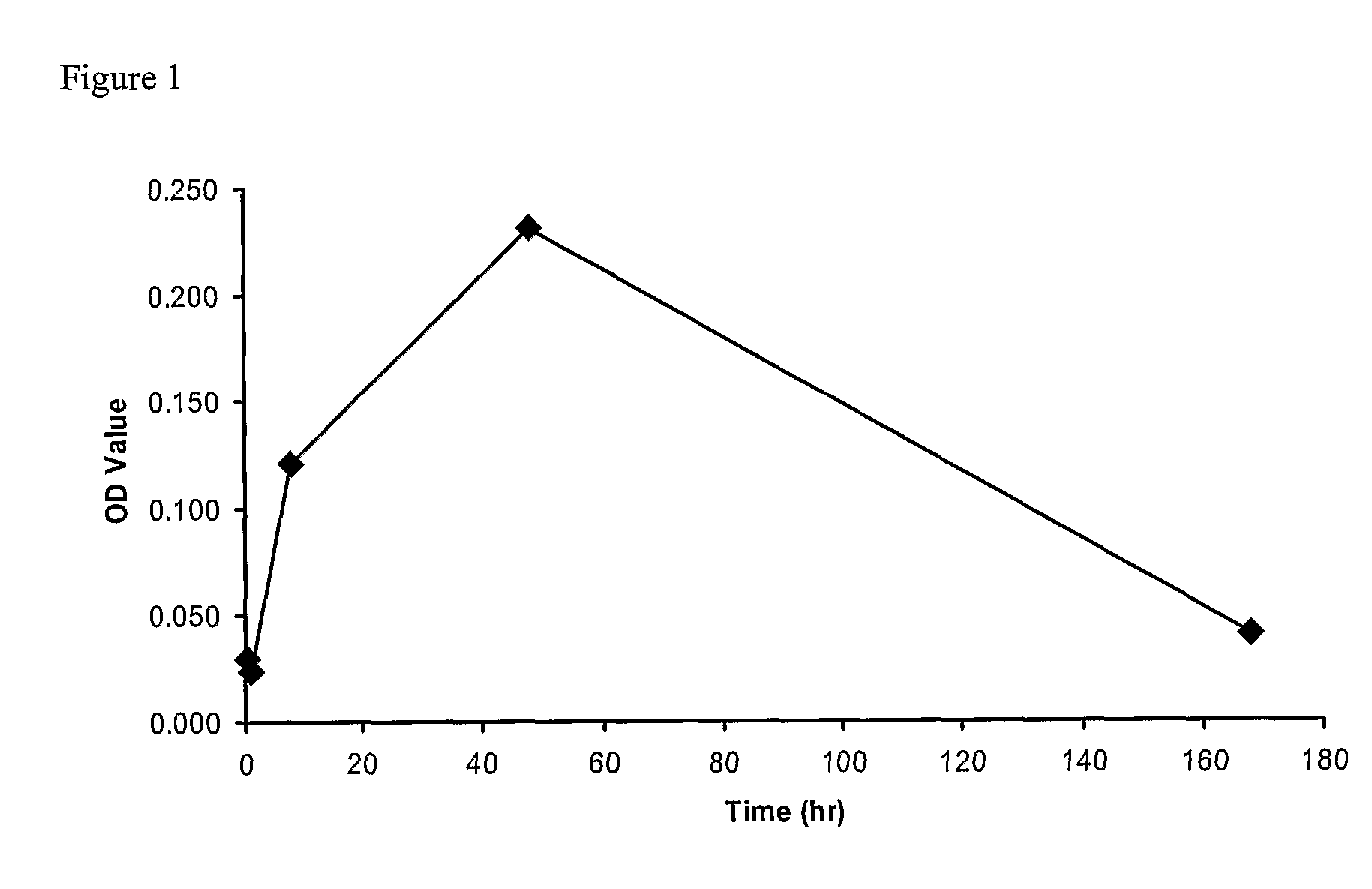Ligands That Enhance Endogenous Compounds
a technology of endogenous compounds and ligands, applied in the field of ligands that enhance endogenous compounds, can solve the problems of low yield, high cost, and undesirable effects, and achieve the effect of increasing the half-life of an endogenous target compound
- Summary
- Abstract
- Description
- Claims
- Application Information
AI Technical Summary
Benefits of technology
Problems solved by technology
Method used
Image
Examples
example 1
Extension of the Serum Half-Life of Tumour Necrosis Factor (TNF)
[0334] Mice transgenic for human TNF (Tg197) were administered in groups of 10 animals with weekly intraperitoneal doses of anti-TNF dAbs which had been reformatted either as dimers with a 40k branched PEG (termed PEG TAR1-5-19) or as a fusion with an anti-serum albumin dAb (termed TAR1-5-19 / MSA trimer). Saline administration was used as a control. After 7 weeks of drug administration the serum of the animals was analysed for circulating TNF levels using an anti-TNF sandwich ELISA kit. Animals administered saline had a circulating TNF level of 25.6 pg / ml whereas animals receiving TAR1-5-19 / MSA trimer had TNF levels elevated to 28.8 pg / ml and PEG TAR1-5-19 had levels elevated to 2315 pg / ml. This clearly demonstrates that dAbs with an extended serum half-life can increase the circulating levels of a molecule with a short serum half-life such as a cytokine and therefore increase the serum levels.
example 2
Extension of the Serum Half-Life of Soluble Tumour Necrosis Factor Receptor 1 (sTNFR1)
[0335] CD1 mice were administered a single intravenous 1 mg / kg dose of an anti-mouse TNFR1 dAb which had been reformatted (extende half-life formats) with either a 40k branched PEG (termed PEG anti-TNFR1 dAb) or as a fusion with an anti-serum albumin dAb (termed anti-TNFR1 / anti-SA dimer). Serum was examined at various time points for levels of soluble TNFR1 using a anti-TNFR1 sandwich ELISA as detailed below.
Measurement of TNFR1
[0336] F96 Maxisorp 96 well flat bottom immunoplates (Nunc, Cat No: 439454) were coated with anti-mouse sTNF R1 / TNFRSF1A antibody (50 ul per well at 1 ug / ml in PBS). Plates were incubated for 1 hr at room temperature. Plates were washed three times with 200 ul PBS. Non-specific binding was blocked with 3% BSA / PBS for 1 hr at room temperature. Plates were washed three times with 200 ul PBS / 0.05% Tween-20.
[0337] Dilutions of recombinant mouse sTNF R1 (R & D Systems, cat# ...
example 3
dAbs that Bind Receptor Molecules But do not Bind the Active Site
[0343] This example illustrates a method for identify dAbs that bind a desired receptor molecule but does not bind the active site of the receptor. The approach is illustrated using tumor necrosis factor 1 receptor (TNFR1), and is generally applicable to receptor molecules.
[0344] Chimeric receptor molecules made up of different murine TNFR1 domains and human TNFR1 domains (Banner D W, et al. Cell, 73(3):431-45 (1993).) such that the molecule contains the four defined extracellular domains of TNFR1 but that these vary in origin between mouse and human TNFR1 proteins were produced. The produced chimeric receptors shared properties of both human TNFR1 and mouse TNFR1 according to the differing domain roles and functionality. The molecules provided a means for the assessment of the domain specificity of dAbs, antibodies and antigen-binding fragments thereof and other molecules (eg protein domains such as affibodies, LDL ...
PUM
| Property | Measurement | Unit |
|---|---|---|
| vivo half life | aaaaa | aaaaa |
| inhibitory concentration | aaaaa | aaaaa |
| soluble | aaaaa | aaaaa |
Abstract
Description
Claims
Application Information
 Login to View More
Login to View More - R&D
- Intellectual Property
- Life Sciences
- Materials
- Tech Scout
- Unparalleled Data Quality
- Higher Quality Content
- 60% Fewer Hallucinations
Browse by: Latest US Patents, China's latest patents, Technical Efficacy Thesaurus, Application Domain, Technology Topic, Popular Technical Reports.
© 2025 PatSnap. All rights reserved.Legal|Privacy policy|Modern Slavery Act Transparency Statement|Sitemap|About US| Contact US: help@patsnap.com


